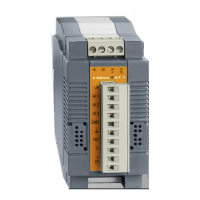e.bloxx A6-2CF
CONFIGURATION
HB_EBLOXX-A62CF_E_V19.doc
61
Gantner Instruments Test & Measurement GmbH
The engineering unit of variable out can be selected. If there are different units at the input variable (e.g. kN and kNm or
N and lbf) no unit should be set. The output variable shows the value, corresponding to the selected input variable.
Syntax: select(select variable;variable1;variable2;variable3;…variable8)
Example:
The application requires the four signals at the analog output: Pressing Force, Unbalanced Value,
Maximum and Envelope Signal. The selection should be done by the digital inputs DI1 and DI2.
The left picture shows the creation of the selection variable, in this case V5.
V5 = DI1 + 2*DI2
So it is possible to get the values 0, 1, 2 and 3 from the binary steps 00, 01, 10, 11.
The right window shows the select function. The variable V6 (OUT) will be selected out of the possibilities V1, V2, V3
and V4. Is e.g. the digital input DI1 = 0 and the DI2 = 1, the variable V5 = 2. The function select will choose the input
variable in position 3 (count from 0), means variable 3 = Maximum.
V6=select(V5;V1;V2;V3;V4)
How to connect the analog output will be shown later.
• Special 1…4 [spec1]
This buttons permit to define more complex functions like combination of conditionings and mathematics. This could be
a semi-automatically process control or a complex conditioning like stress analysis. The programming of the special
function has to be done according the customers requirements by Gantner Instruments Test & Measurement.
• Constant [const]
In this pop-up menus the software offers constants like Pi, e or g, to use them in calculations.
Combination of the Conditioning Functions
The arithmetic functions can be used more than once per function, parallel and in combinations. The arithmetic
functions can also be used in combination with the functions of the group signal conditioning.
Note:
Using a number of arithmetic function (number of math operations) will reduce the calculation rate. To use
the signals of the group signal conditioning in combination with the arithmetic functions the result will have a
lower conditioning rate. E.g. the Maximum will detected with 5000 samples/s. A multiplication of the
maximum with a constant will provide a lower rate of e.g. 500 samples/s.

